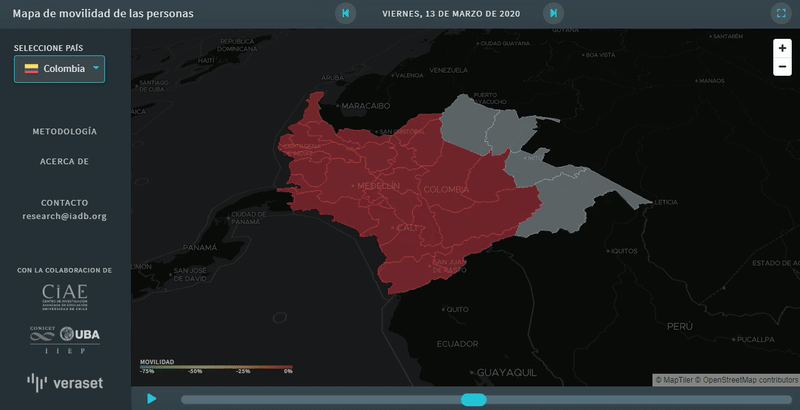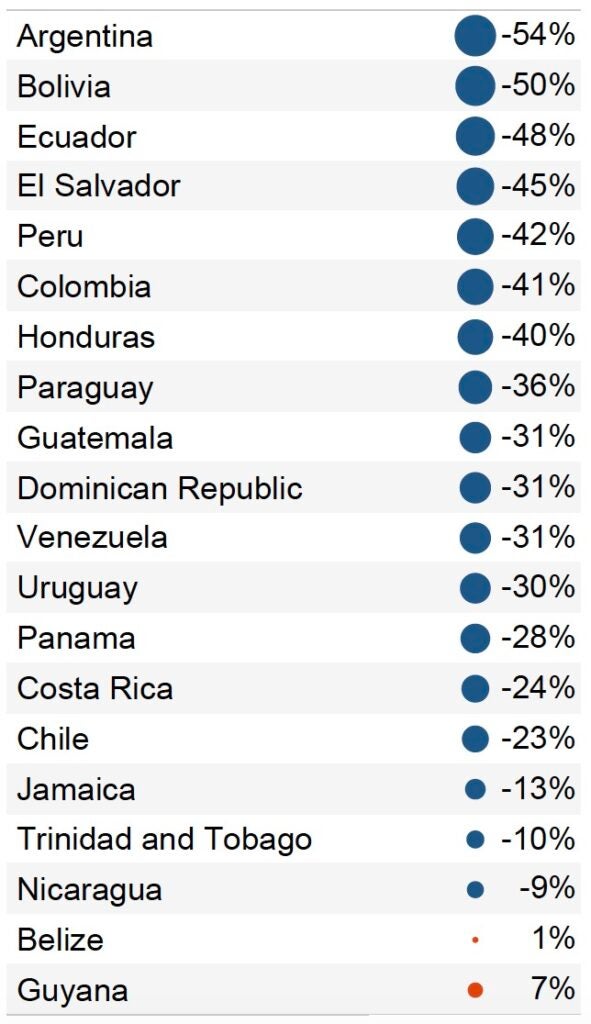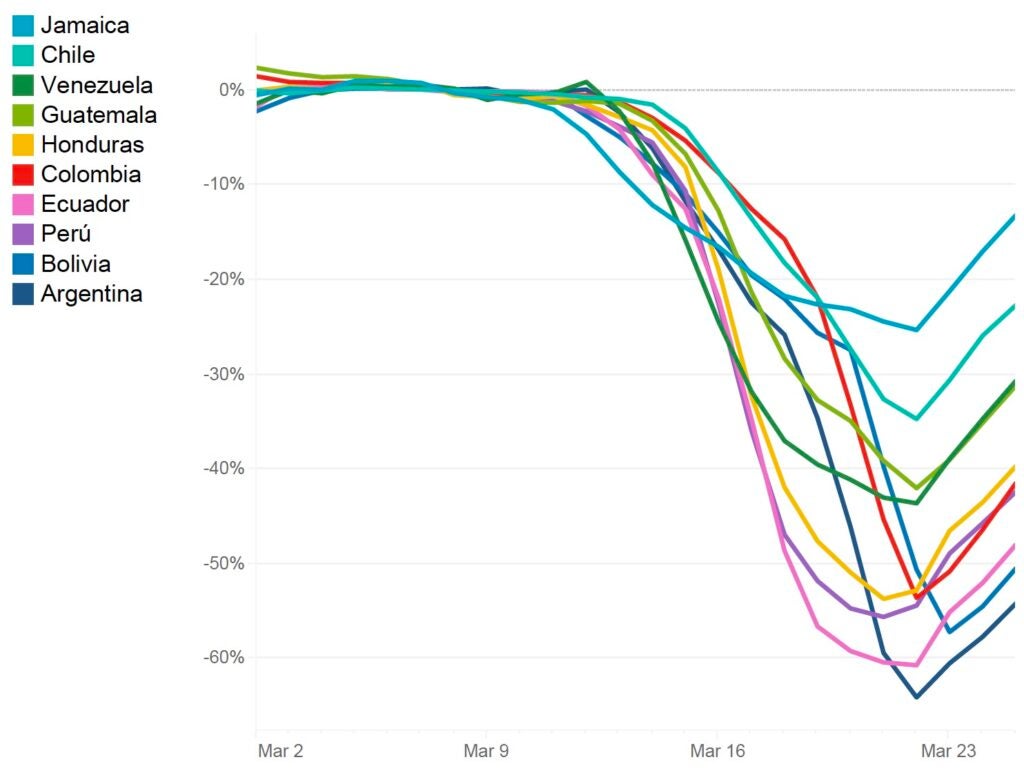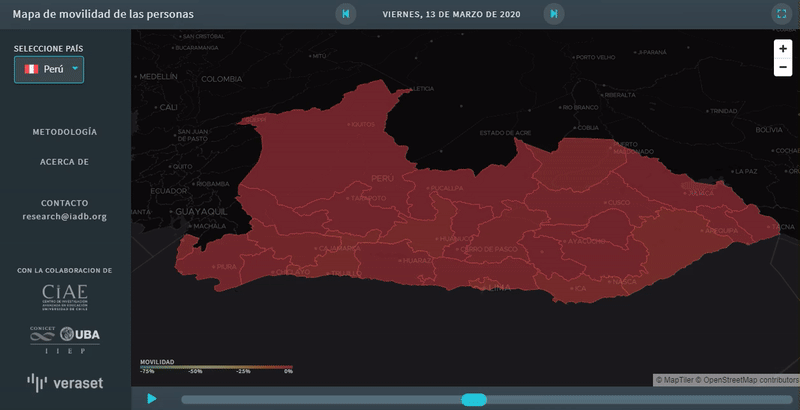In recent weeks, the governments of Latin America and the Caribbean have implemented a battery of measures to encourage social distancing and reduce the infection rate of the coronavirus. Although it is clear that human mobility has indeed dropped significantly, important questions persist.
How much has mobility declined in the region? In what countries has it dropped the most and why? When did mobility begin declining and how has it trended over time?
Governments need answers with clear, objective, and precise information, information that is vital for them to be able to understand the context in which they are operating. This information could also shed light on the impact of the measures implemented, where they have been most strictly observed, and how their impact has developed over time.
With the launch of the Human Mobility Map, we hope to help answer these questions and support governments’ efforts to beat the coronavirus pandemic. Specifically, the map offers mobility statistics with a high degree of spatial and temporal granularity. The tool gives the percentage decline—compared to a reference week, March 5 through 11—in the number of people who have traveled more than 1 km per day.
The tool breaks the statistics down by department, state, province, or region for 20 countries in Latin America and the Caribbean. The statistics were gathered using geo-referenced and anonymized cell phone data (see more on the methodology here). The tool is dynamic: It shows country maps with color shifts to show how mobility is trending as time passes. The tool is also interactive, enabling users to select a date to track mobility in different parts of a country. Also, users can click on provinces or regions to view graphs showing how mobility has trended in each area.
The data show that, in the countries analyzed, the number of people who travel more than 1 km per day has fallen by almost a third. To be sure, this average conceals significant heterogeneity, as shown in the following table.
Percentage of people that travel more than 1 km
Percentage change by March 25 with respect to the week of March 5-11
Specifically, countries like Argentina, Bolivia, and Ecuador have seen declines of 48% or more. On the other hand, the decline has been much less in other countries like Nicaragua, Belize, and Guyana, where mobility dropped by less than 10%.
What could explain these differences between countries? One plausible explanation could be the significant role played by obligatory general isolation measures implemented by governments. In fact, the 9 countries that have experienced the largest decreases in mobility have introduced these measures (the other country that hast implemented them is Venezuela). However, it is important to recognize that countries that implemented mandatory general isolation have also imposed other measures to reduce mobility. Thus, in subsequent analysis, we will go into more depth on the causes of the heterogeneity documented here.
While it is important to compare the “snapshot” of the post-coronavirus period with that of the pre-coronavirus period, it can also be useful to analyze the mobility trend over time. Thus, the following graph shows the trajectory of mobility in the 10 selected countries.
Percentage of people that travel more than 1 km
Daily percentage change with respect to the week of March 5-11
It shows that the decline in mobility was relatively synchronized in the countries of the region. Specifically, mobility began to decline around March 14 and continued to fall to its lowest point on March 22, after which it “rebounds” and finishes the period in question slightly higher. Although it is difficult to determine the exact days on which the trend breaks, these results suggest that the transition between the “pre-corona” and “post-corona” world, in terms of mobility, took place around these dates.
The results described here are just a small sample of the data contained in the Human Mobility Map. Indeed, the idea behind this project is to provide access to daily statistics aggregated at the provincial and regional level so it can be used by analysts and decision-makers in both the public and private sectors.
To facilitate this use, in addition to the aforementioned visualization tool that involves the use of maps, the results have also been included in a new section on human mobility in the IDB Coronavirus Impact Dashboard. Dashboard users can select specific countries to see how their mobility indicators have trended over time. Users can also select provinces and regions within countries.
It should be emphasized that we are following a strict protocol to protect the privacy of the data used. We were able to access a database of geo-referenced cellular phones from a company called Veraset, which has provided this data before to academics to study different economic and social issues. The database obtained contains anonymized data (that is, with no names or cell numbers), and includes no sociodemographic indicators like gender, age, or socioeconomic status. We adhered to high cybersecurity standards to guarantee the security of the data, which is only used to perform the kind of aggregated analysis we are presenting here. We are only publishing results for geographic areas with a minimum of 100 cellular phones per day during the period under analysis.
We hope this Human Mobility Map and the IDB’s new Coronavirus Impact Dashboard will be useful tools for those wishing to study how social distancing is affecting human behavior. Right now, these tools have data through March 25, and we hope to add updated data over the next few days. We also welcome comments and suggestions of complementary analysis that would enable us to provide better quality and more relevant information as we take part in the difficult struggle against the coronavirus.






By providing evidence-based data, the findings of this analysis will be extremely helpful to evaluate areas of contagion and assist governments in policy decisions on how to start alleviating lock down measures in the short-term and gradually start bringing life to the “new normal” . This can also be a good tool for a long-term strategy since it is foreseen that the world will face several waves of ups and downs of Covid-19 contagion in the future.
Looking forward to seeing data from Brazil where social distancing measures started as from March 16,2020.
Hi Edna,
We are working on adding Brazil to the Human Mobility Map. We also hope this tool will be used by the governments in the region to help make better decisions.
Best,
Tom